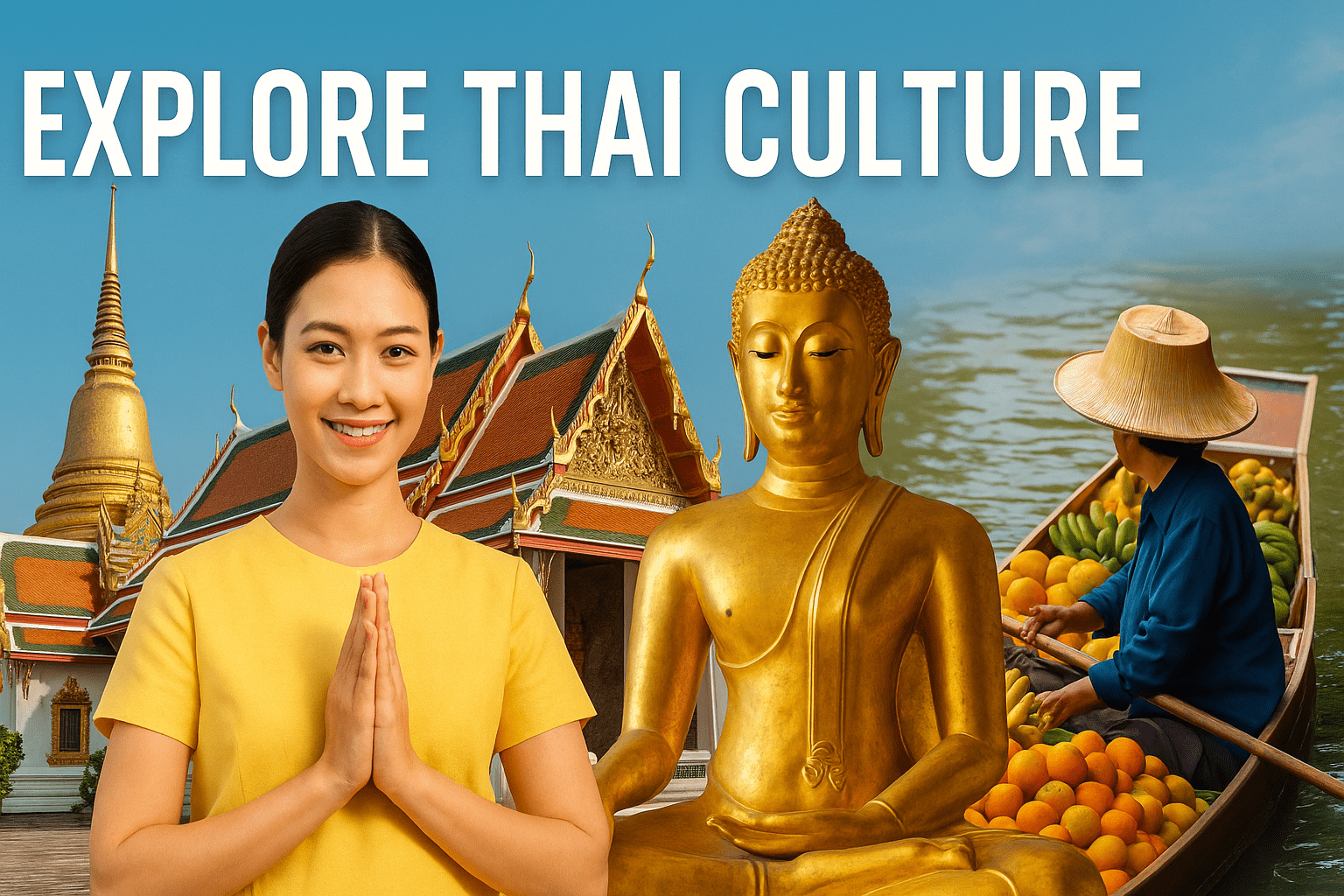
Thailand, the “Land of Smiles,” beckons travelers with its stunning landscapes, delectable cuisine, and vibrant culture. But beneath the surface of bustling markets and serene temples lies a wealth of rich traditions and customs that have shaped Thai society for centuries. Understanding these traditions not only enhances your travel experience but also fosters a deeper appreciation for the Thai people and their way of life. Let’s embark on a journey to explore the fascinating tapestry of Thai culture.
At the heart of Thai culture lies a blend of Theravada Buddhism, animistic beliefs, and Hindu influences. These elements have intertwined over centuries to create a unique set of social norms, etiquette, and celebratory practices. To truly appreciate Thailand, we must delve into the historical roots that nourish its present-day customs.
Buddhism, introduced to Thailand centuries ago, plays a vital role in shaping moral values and social behavior. Concepts like karma, reincarnation, and the pursuit of enlightenment permeate daily life. Animistic beliefs, predating Buddhism, still hold sway, with spirits believed to inhabit natural elements like trees, mountains, and rivers. The influence of Hinduism, particularly in royal ceremonies and artistic expression, adds another layer of complexity to the cultural landscape.
Let’s explore some specific traditions and customs that you’re likely to encounter in Thailand:
The Wai
Perhaps the most ubiquitous Thai custom is the “Wai.” This slight bow, with palms pressed together in a prayer-like gesture, is a greeting, a thank you, a sign of respect, and an acknowledgment of status. The height of the hands and the depth of the bow vary depending on the social standing of the individuals involved. A younger person will Wai an elder, a student will Wai a teacher, and so on.
It’s crucial to reciprocate a Wai, although tourists are not expected to initiate one. When receiving a Wai from someone younger or of lower status, a simple nod of the head is sufficient. Misunderstanding this subtle yet important custom can easily lead to unintended offense.
Respect for Elders
In Thailand, age is synonymous with wisdom and experience. Showing respect for elders is deeply ingrained in the culture. This respect manifests in various ways, from offering them seats on public transportation to speaking to them in a respectful tone. This concept ties into the idea of maintaining “face,” a crucial element in Thai social interactions. Losing face, or causing someone else to lose face, can damage relationships and create unnecessary conflict.
The Importance of “Face” (Kreng Jai)
“Kreng Jai” is a complex concept that encompasses consideration, deference, and avoiding causing discomfort to others. It’s about being mindful of others’ feelings and maintaining harmony in social interactions. This often means avoiding direct confrontation, even when disagreeing. For example, a Thai person might say “yes” to a request even if they know they cannot fulfill it, to avoid causing disappointment. Understanding Kreng Jai is essential for navigating social situations with grace and sensitivity.
The concept of Kreng Jai highlights the collectivist nature of Thai society. It emphasizes the importance of group harmony and interdependence. This stands in contrast to more individualistic cultures where personal desires and opinions are often prioritized.
Festivals and Celebrations
Thailand is renowned for its vibrant festivals, which offer a glimpse into the country’s rich cultural heritage.
Songkran, the Thai New Year, is perhaps the most famous. This multi-day celebration involves water fights, temple visits, and traditional performances. Water symbolizes purification and washing away bad luck, making Songkran a joyous and exhilarating experience. Another significant festival is Loy Krathong, where people release decorated floats (Krathongs) onto rivers and waterways to honor the water goddess and ask for forgiveness.
These festivals are not just opportunities for revelry; they also serve to reinforce social bonds and preserve cultural traditions. Family reunions, religious ceremonies, and community events are integral parts of these celebrations. Understanding the underlying significance of these festivals allows visitors to engage respectfully and appreciate their cultural value.
Temple Etiquette
Temples (Wats) are sacred places in Thailand, and visitors are expected to adhere to certain rules of etiquette. Dress modestly, covering your shoulders and knees. Remove your shoes before entering the main temple building. Avoid pointing your feet at Buddha images or monks, as the feet are considered the lowest part of the body. Speak softly and avoid loud conversations. Taking photographs is generally allowed, but be respectful and avoid using flash photography near Buddha images. Women should never touch a monk or hand anything directly to one. Place the object on a surface for the monk to pick up. These simple acts of respect demonstrate your understanding of Thai culture and religious beliefs.
“I’ve learned that people will forget what you said, people will forget what you did, but people will never forget how you made them feel.”
Food Culture
Food is an integral part of Thai culture. Meals are often shared family style, with a variety of dishes placed in the center of the table for everyone to enjoy.
Using your fork to push food onto your spoon (your primary eating utensil) is customary. Avoid using your chopsticks to eat rice, as this is considered impolite. Tipping is not generally expected in Thailand, but rounding up the bill is appreciated. Remember, smiling and expressing your enjoyment of the food goes a long way in showing appreciation to your host.
Modern Thailand and the Preservation of Tradition
While Thailand has embraced modernity, its people remain deeply connected to their cultural heritage. Efforts are underway to preserve traditional arts, crafts, and performing arts. The government and various organizations actively promote cultural tourism, encouraging visitors to learn about and appreciate Thai culture.
However, it’s important to be mindful of the potential for commercialization and to seek out authentic experiences that support local communities. We can promote cultural sensitivity and authenticity by engaging with locals, learning about their traditions, and supporting local businesses.
Imagine this: You’re at a local market, trying to bargain for a souvenir. Instead of directly negotiating a lower price, you smile, express your admiration for the craftsmanship, and perhaps share a few words in Thai (even just “Sawasdee” – hello – and “khop khun” – thank you). The vendor, appreciating your effort to connect and show respect, is more likely to offer a fair price. This simple act of cultural sensitivity can lead to a more positive and rewarding interaction.
Navigating the nuances of Thai culture can seem daunting at first, but by embracing a spirit of curiosity, respect, and genuine interest, you can create meaningful connections and gain a deeper understanding of this fascinating country. Remember that mistakes are inevitable, but learning from them and demonstrating a willingness to learn is key. Don’t be afraid to ask questions, observe local customs, and engage with Thai people in a respectful and open-minded manner.
Understanding the rich traditions and customs of Thailand allows for more meaningful and respectful travel experiences. It enriches the experience by providing a deeper understanding of Thai values and beliefs. As travelers, it’s important to move beyond surface-level observations to engage with cultures on a meaningful level. Remember that Thai culture values politeness, respect, and non-confrontation. Therefore, maintaining a calm and respectful demeanor will enhance your interactions with Thai people.
Parting Thoughts
In conclusion, exploring the rich traditions and customs of Thailand is an ongoing journey of discovery. By understanding the historical roots, appreciating the nuances of social etiquette, and embracing a spirit of respect, we can foster meaningful connections and gain a deeper appreciation for the Thai people and their vibrant culture. Let’s continue to learn, grow, and celebrate the beauty of cultural diversity.
The next time you visit Thailand, remember the Wai, be mindful of Kreng Jai, dress appropriately when visiting temples, and show respect for elders. By doing so, you will not only enhance your own experience but also contribute to a more positive and enriching cultural exchange. Safe travels, and happy exploring! Don’t forget to try the amazing food and enjoy the beautiful landscapes. Keep learning about the local culture and its unique traditions.







